
- English
- ePUB (mobile friendly)
- Available on iOS & Android
eBook - ePub
The Cold War: History in an Hour
About this book
Love history? Know your stuff with History in an Hour.
Frequently asked questions
Yes, you can cancel anytime from the Subscription tab in your account settings on the Perlego website. Your subscription will stay active until the end of your current billing period. Learn how to cancel your subscription.
At the moment all of our mobile-responsive ePub books are available to download via the app. Most of our PDFs are also available to download and we're working on making the final remaining ones downloadable now. Learn more here.
Perlego offers two plans: Essential and Complete
- Essential is ideal for learners and professionals who enjoy exploring a wide range of subjects. Access the Essential Library with 800,000+ trusted titles and best-sellers across business, personal growth, and the humanities. Includes unlimited reading time and Standard Read Aloud voice.
- Complete: Perfect for advanced learners and researchers needing full, unrestricted access. Unlock 1.4M+ books across hundreds of subjects, including academic and specialized titles. The Complete Plan also includes advanced features like Premium Read Aloud and Research Assistant.
We are an online textbook subscription service, where you can get access to an entire online library for less than the price of a single book per month. With over 1 million books across 1000+ topics, we’ve got you covered! Learn more here.
Look out for the read-aloud symbol on your next book to see if you can listen to it. The read-aloud tool reads text aloud for you, highlighting the text as it is being read. You can pause it, speed it up and slow it down. Learn more here.
Yes! You can use the Perlego app on both iOS or Android devices to read anytime, anywhere — even offline. Perfect for commutes or when you’re on the go.
Please note we cannot support devices running on iOS 13 and Android 7 or earlier. Learn more about using the app.
Please note we cannot support devices running on iOS 13 and Android 7 or earlier. Learn more about using the app.
Yes, you can access The Cold War: History in an Hour by Rupert Colley in PDF and/or ePUB format, as well as other popular books in History & 20th Century History. We have over one million books available in our catalogue for you to explore.
Information
Appendix 1: Key Players
Joseph Stalin 1879–1953
Born 21 December 1879, Josef Vissarionovich Dzhugashvili is better known to history by his adopted name – Stalin, ‘man of steel’.
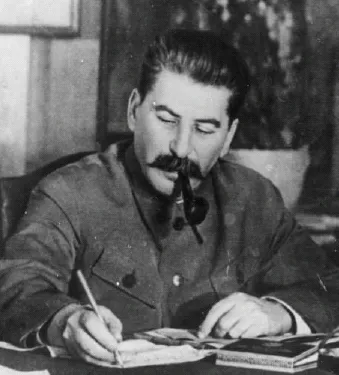
Joseph Stalin, 1949
Bundesarchiv, Bild 183-R80329 / CC-BY-SA
Training to be a priest, Stalin was expelled from his seminary in 1899 and from there followed the revolutionary path of a Marxist.
Following the October Revolution in 1917 and the formation of the Soviet Union, Lenin delegated numerous tasks to his eager protégé, culminating in 1922 with Stalin’s appointment as general secretary of the Communist Party. But Lenin began to regret his decision and Stalin’s fast-track rise through the party hierarchy, believing Stalin to lack the necessary tact and skill for such a post. In January 1923, Lenin penned a secret memorandum, known as Lenin’s Testament, suggesting Stalin’s removal from power: ‘I am not sure whether [Stalin] will always be capable of using [his] authority with sufficient caution … Stalin is too rude and this defect … becomes intolerable in a secretary general. That is why I suggest that the comrades think about a way of removing Stalin from that post and appointing another man in his stead.’
The other man Lenin had in mind was Stalin’s great rival Lev Trotsky. Together with Trotsky, Lenin was going to use the party congress in April that year as his opportunity to have Stalin removed. But in March Lenin suffered a stroke, his third, which confined him to home and effectively ended his political career.
In January 1924 Lenin died. Trotsky may have been the obvious successor but two of his rivals, Lev Kamenev and Grigori Zinoviev, suppressed Lenin’s memorandum and decided to side with Stalin, from whom they felt they had nothing to fear. Trotsky was promptly sidelined and eventually expelled from the party and exiled from the country. But if Kamenev and Zinoviev thought they could tame the Georgian beast they were wrong. Stalin sided with Nikolai Bukharin to have them removed from the party before turning on Bukharin as well. Between 1936 and 1938 Kamenev, Zinoviev and Bukharin were all put on show trial accused of ridiculous charges, sentenced and executed.
Stalin’s final years were marked by increasing paranoia and obsession about security to the point he trusted no one, including, as he once said, himself.
In March 1953, Stalin suffered a stroke and, unable to move or call for help, was left unaided, his staff too fearful to disturb him. He died on 3 March, a victim of his own power.
Stalin’s body was embalmed and placed next to Lenin’s. But in 1961, during the years of de-Stalinization, the body was removed from its pride of place and reburied in a common grave along the Kremlin wall.
Mao Zedong 1893–1976
The son of a wealthy peasant farmer, Mao Zedong (also Mao Tse-Tung) was born in Hunan Province, in south-central China, in 1893. Aged thirteen, he began working on the family farm and was forced into an arranged marriage. He left home to escape his overbearing father and the rigours of rural life. He served briefly in the revolutionary army during the 1911 Chinese Revolution which saw the end of the Qing Dynasty and the formation of the Chinese republic. As a student he began dabbling in politics, then worked as a library assistant at Peking University, during which time he converted to Marxism.
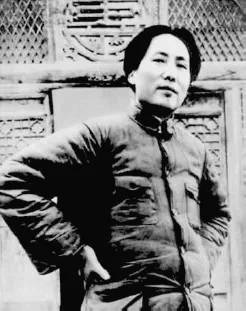
Mao Zedong, 1946
Mao was an early supporter of the Chinese Communist Party (CCP), established in Shanghai in June 1921.
Having originally turned his back on the rural life, he began to see the future of revolutionary power not in the urban classes but in the countryside. He established various peasant organizations, giving the peasants a political voice.
In 1923, the communists formed an alliance with the Kuomintang (Nationalist Party) and Mao became a member of its Executive Bureau and head of its propaganda arm. But following the death of the Nationalist Party leader, Chiang Kai-Shek was appointed leader of the Kuomintang, and immediately began purging the party of its communist element. Its survivors forced to relocate in what became known as the Long March, with Mao leading 100,000 followers over 8,000 miles into north-west China
During China’s struggle against Japan, Mao’s communists and Chiang Kai-Shek’s nationalists joined forces, but following the end of World War Two and the surrender of Japan, the two parties fought a civil war. Having finally defeated the Chinese Nationalists, Chairman Mao proclaimed the People’s Republic of China on 1 October 1949, with the words: ‘The Chinese people have now stood up!’
Harry S. Truman 1884–1972
In January 1945 Truman was appointed US vice-president, but following Roosevelt’s death eleven weeks later, found himself taking the leading role as the Second World War drew to a close. He remains the only person in history to authorize the use of atomic weapons which, in August 1945, brought about Japan’s surrender and the end of the war.
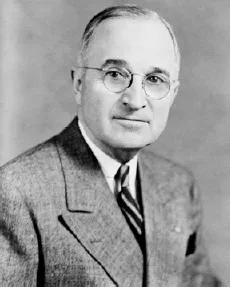
Harry S. Truman, 1945
Edmonston Studio
In March 1947, Truman articulated the need to alleviate poverty within Europe to prevent extreme ideologies taking route. ‘The seeds of totalitarian regimes,’ he said, ‘are nurtured by misery and want.’ In other words, communism appealed to those suffering from hardship. Remove the hardship; you remove the appeal of communism. Known as the ‘Truman Doctrine’, Truman believed that communism had to be contained, and that America could not, as it did after the First World War, turn its back on Europe – isolationism was no longer an option. In the post-war era a stable Europe and the future of the ‘free world’ was a necessity.
The Truman Doctrine initiated the European Recovery Programme, more commonly known as the Marshall Plan, after its facilitator, George C. Marshall.
Truman also oversaw the successful Berlin Airlift and the formation of NATO but his later years in office were overshadowed by the Korean War.
Dwight D. Eisenhower 1890–1969
During the Second World War, Eisenhower, as supreme commander of Allied Forces, masterminded the D-Day landings in Normandy and the subsequent battle for France and push into Germany.
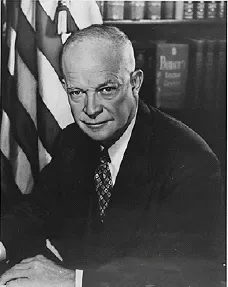
Dwight D. Eisenhower
He was often resented for his lack of combat experience, but was known for his diplomacy, bringing together a sense of collaboration between the British and Americans, and his ability to cope with conflicting egos.
Post-war Eisenhower was feted by both the Republicans and Democrats but served in various non-political posts, culminating with his appointment as supreme commander of NATO. In 1952 he resigned from the army and entered politics as the Republican candidate for the presidency, winning the November 1952 election under the slogan ‘I like Ike’. He brought about the end of the Korean War, and allowed Joseph McCarthy free rein in the anti-communist witch-hunts.
He was re-elected in 1956.
Nikita Khrushchev 1894–1971
A devoted servant of Stalin, Khrushchev survived the Great Purges and, having actively supported them, rose through the ranks of the Soviet hierarchy. Following Stalin’s death in March 1953, Khrushchev emerged from the political manoeuvring within the Politburo to become Stalin’s unlikely successor.
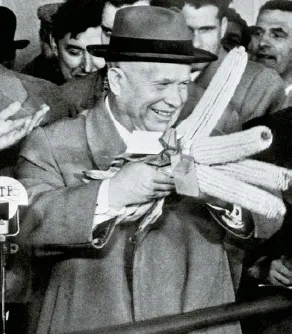
Nikita Khrushchev
A Ukrainian peasant by origin, Khrushchev was impulsive, rotund, by turns vindictive and charming. During a UN meeting in New York in October 1960, Khrushchev famously protested against the proceedings by banging his shoe against his desk. But his ‘different roads to socialism’ meant a very different type of leadership to that of his predecessor.
In February 1956, at the Soviet Twentieth Party Congress, in front of a gathering of the Kremlin hierarchy, Khrushchev delivered a six-hour speech in which he denounced Stalin’s reign and his cult of personality whilst promising a degree of autonomy to the countries of the Eastern Bloc.
Khrushchev loved to travel. In September 1959, he visited the USA, and on a tour of the country, was impressed and intimidated in equal measure. Two months earlier, in an exchange with the US Vice President, Richard Nixon, Khrushchev said, ‘We [the Soviet Union] have existed not quite forty-two years but in another seven years we will be on the same level as America. When we will catch you up, and in passing you by, we will wave to you.’
The Soviet Union’s relations with China fared little better during Khrushchev’s term in power. Chairman Mao viewed with growing disdain what he saw as the Soviet Union’s coexistence with America. Khrushchev’s withdrawal of missiles from Cuba was, to Mao, further evidence of his weakness.
Khrushchev dealt brusquely with the 1953 uprisings, first in Poland, then in Hungary; and in 1962 brought the world to the brink of nuclear war during the Cuban Missile Crisis.
Domestically, Khrushchev’s attempts at introducing new initiatives, such as harvesting grain in Central Asia, backfired despite some initial success, leaving whole tracts of land useless.
In 1964, Khrushchev was disposed and immediately sidelined. Depressed and isolated, Khrushchev dictated his memoirs, which, although denounced by the Soviet Union, were published to much acclaim in the West. He died in 1971 but was denied a state funeral and a place of honour in the Kremlin Wall. His death was announced by Pravda with a single sentence.
John Fitzgerald Kennedy 1917–63
John Fitzgerald Kennedy graduated from college with the ‘Most Likely to Succeed’ prize. An energetic child and fond of practical jokes, Kennedy was nonetheless beset with ill health from an early age.
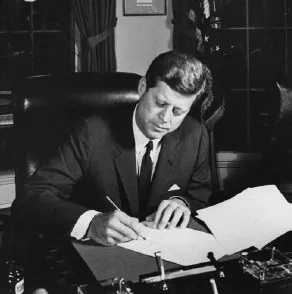
John Fitzgerald Kennedy, 1962
Cecil Stoughton, White House
The son of the US ambassador to the UK, Kennedy was well travelled and was in London the day Germany invaded Poland, thus triggering the Second World War. Kennedy wrote a book about Britain’s policy regarding Hitler, Why England Slept, which became a bestseller.
Rejected by the US army because of his back pain, an ailment that would haunt him his whole life, Kennedy joined the navy in 1941, becoming an intelligence officer, and was later promoted to lieutenant in the Motor Torpedo Boat Squadron.
In August 1943, patrolling near the Solomon Islands in the South Pacific, Kennedy’s boat was hit by a Japanese destroyer. Two of his men were killed outright but Kennedy and the six surviving crew members clung to the wreckage of the boat. Kennedy managed to get his men to safety, for which he earned a medal and high praise.
His older brother, Joseph Junior, was killed during the war in 1944.
In 1952, Kennedy was elected to the US Senate but his rise through the ranks of the Democrat Party was hampered by continuing back problems, twice needing major spinal surgery. On one occasion, he become so ill, Kennedy received his last rites. In 1956, whilst recovering from surgery, Kennedy wrote a biographical book about US senators, a publication that won him the 1957 Pulitzer Prize for Biography.
Aged forty-three, Kennedy became the youngest elected US president, when in November 1960 he defeated the future president, Richard Nixon, by a mere 0.3 per cent. He was also the first Roman Catholic to hold the post. Popular and respected, his youth symbolized a new, bright beginning within the free world.
However, in April 1961, a US-backed invasion of Cuba at the Bay of Pigs failed to raise a counter-uprising against the newly installed Marxist reg...
Table of contents
- Cover
- Title Page
- About History in an Hour
- Contents
- Introduction
- The End of the Second World War: Apocalypse
- The Beginning of the Cold War: The Freeze
- Three Speeches: ‘An iron curtain has descended’
- The Marshall Plan: ‘Communism cannot be stopped in Europe’
- Berlin: ‘You should not and cannot abandon this city and this people’
- The Bomb: ‘MAD’
- The Korean War: Hot War
- US Anti-Communism: ‘Reds Under the Bed.’
- Stalin’s Final Years: ‘I’m finished, I don’t even trust myself’
- Khrushchev: ‘Different roads to socialism’
- Space Wars: ‘Flopnik’
- The Berlin Wall: ‘Berlin is the testicles of the West’
- The Cuban Missile Crisis: ‘We’ll all meet together in Hell’
- The Vietnam War: Unwinnable
- Rebellion: 1968
- Nixon: ‘Vietnamization’
- China, the USA and the Soviet Union: ‘Ping-pong diplomacy’
- The Decline of Détente: ‘Lennonism, not Leninism’
- Afghanistan: ‘The Soviet Vietnam’
- The Polish Pope and Solidarity: ‘The last nails in the coffin of communism’
- The Ex-Actor: ‘Regimes planted by bayonets do not take root’
- Gorbachev: ‘Mr Gorbachev, tear down this wall!’
- 1989: ‘Time to yield power’
- The End of the Soviet Union: ‘The threat of a world war is no more’
- Appendix 1: Key Players
- Appendix 2: Timeline of the Cold War
- Copyright
- Got Another Hour?
- About the Publisher